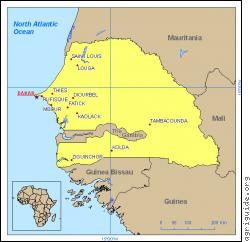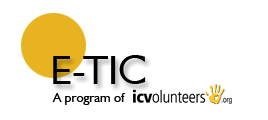RegionsSenegal  E-TIC works in the following areas in Senegal:
Information about the countryPopulation: 13.711.597 (July 2009 est.), Capital Dakar, 1.729.823 Agriculture and livestockThe principle agricultural products are: groundnuts, millet, maize, sorghum, rice, cotton, tomatoes and green vegetables. Cattle, poultry, pigs and fish are the most important products in terms of livestock. Public interest in, and opinion about, agriculture and livestock is currently limited, although they are important sectors for the country. One of the key issues for the country is understanding how to become more self-sufficient in terms of food. Most of Senegal's landmass lies in the Sahel region, subject to drought with irregular rainfall and generally poor soils. Only around 5% of the land is irrigated so the dependence on rain for cultivation leads to great fluctuations in production. Around 70% of the workforce is engaged in agriculture. Agriculture (including forestry, livestock and fishing) makes up 18% of GDP. The majority of farms are small holdings (1.5-2.4 hectares/3.7-5.9 acres) and around 60% are located in what is called the "Groundnut Basin" to the east of Dakar. A large part of farming land is still owned by tribes. Only around 11% of the total area in Senegal is cultivated, the production of millet has increased by 40% and groundnuts by 36%. According to estimates by the Senegalese Government, the country produced around 420,000 tonnes of groundnuts in 2009 compared to 460,000 tonnes in 2006, which was also a bad year with irregular rainfall. Rice: Only 50% of rice needs are covered locally. The rest is imported from Asia as the variety of rice produced there, such as Basmati and fragrant rice, is more sought after than the rice produced locally. People do not want rice if it is not fragrant or treated like Asian rice. Rice is grown as a single crop, a method of farming that was developed in the sixties and taken to Senegal by the French. Groundnuts: Groundnuts are mainly used in the production of oil for export. Trade and EmploymentThe total area of the country equals 196,722 sq km, of which 192,530 sq km is made up of land and 4,192 sq km of water. In 2009, the GDP was estimated at 16 billion, of which 13.8% came from agriculture (other estimates put it at 18%), 23.3% from industry and 62.9% from services. It is estimated that in 2009 exports generated a turnover of ,652 billion:
Imports generated ,864 billion in 2009 for the following products and partners:
The workforce per sector is as follows: agriculture: 77.5%; industry and services: 22.5% (2005 est.) The unemployment rate is estimated at 48% (2007 est.). It is estimated that 54% of the population lives below the poverty line (2001 est.). CommunicationsIn 2008, there were 237,800 telephone land lines and 5,389 million mobile telephones in the country. In 2009, there were 227 internet hosts and 1,02 million internet users (for further information please see the introduction of the report). DemographyIn July 2009, the population of Senegal was estimated at 13,711,597 people, of which 1,729,823 lived in the capital, Dakar and were organized according to age as follows:
The rate of population growth was estimated at 2,709% in 2009. In terms of the population as a whole, 42% live in urban areas with an annual rate of change of 3.1% between 2005 and 2010. Life expectancy at birth is 59 years, 57.12 years for men and 60.93 years for women (2009 est.). EducationThe rate of literary is 39.3%, 51.1% for men and 29.2% for women (2002 est.). Anyone over the age of 15 years is considered to be illiterate if they cannot read or write. Administrative organizationSenegal has a democratic governmental system. The structure of the different levels of government is as follows: Country>District>Commune>Rural Commune>Village. There have been efforts made to decentralize, however, the country remains very centralized as shown by the many communes who have a mayor based in Dakar as well as a local mayor living in the village. HistoryThe French colonies of Senegal and French Sudan, also known as the Republic of Sudan, joined together in 1959 and were recognized as the Federation of Mali in 1960. The union ended after only a few months. Senegal and Gambia formed the Confederation of Senegambia in 1982 but the envisaged integration of the two countries never took place and the union dissolved in 1989. The Movement of the Democratic Forces of Casamance (MFDC) has led a weak insurrection of separatists in the south of Senegal since the 1980s and several peace agreements have failed to resolve the conflict. Nevertheless, Senegal remains one of the most stable democracies in Africa. Senegal was governed by the Socialist Party for 40 years until the election of the current president Abdoulaye Wade in 2000. He was re-elected in February 2007 but amended the Constitution of Senegal on several occasions to increase legislative power and to weaken the opposition. Senegal has a long history as an international peace-keeping actor and as a mediating force in the African region. |

